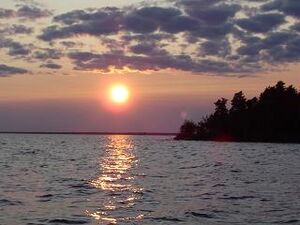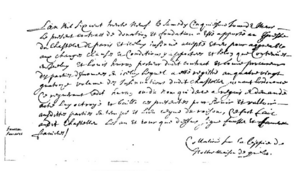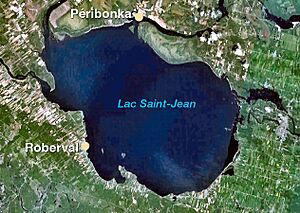Jean de Quen facts for kids
Jean de Quen was a French Jesuit priest and missionary. He was born around 1603 in Amiens, France. He came to New France (which is now Canada) in 1635.
Jean de Quen became a very important leader for the Jesuit missions in New France. He helped start missions in the Saguenay region. In 1647, he was the first European to reach the shores of Piékouagami, which is now known as Lac Saint-Jean.
Contents
Early Life and Work
Jean de Quen joined the Jesuits when he was about 17 years old in 1620. He taught for three years in France. Then, he traveled to New France, arriving in Quebec on August 17, 1635.
He taught at the College of Quebec. This school had just opened that year for both French and First Nations boys. After two years, he moved to the Sillery mission. This mission worked to educate native peoples.
Later, he returned to Quebec to serve the local church. After a fire in 1640, he went back to Sillery. He was in charge of the Sillery mission for eight years, from 1642 to 1649. During this time, he met many First Nations individuals. He became very good at speaking the language of the Montagnais people.
Missions in Tadoussac
In the spring of 1642, Jean de Quen was put in charge of the Montagnais mission. He worked with this mission for 11 years. This mission had started the year before in Tadoussac.
Tadoussac was a busy place for fur trading. First Nations people from all over the Saguenay area came there between spring and late August. Father de Quen was well-respected by the Montagnais. He worked with other priests to create a special summer mission. This mission fit the traveling lifestyle of these nomadic peoples. He helped form a group of Christians who then helped him reach other distant groups. The first stone church in Quebec was built in Tadoussac in 1646.
Exploring Lac Saint-Jean
No European had fully explored the Saguenay River or the large lake that appeared on a map from 1544. Earlier explorers tried to reach the lake but failed. This was because the native peoples did not want white men to know about Lac Saint-Jean.
Jean de Quen wanted to visit the Porcupine nation. They could not come to Tadoussac because of illness. So, he left the Tadoussac mission on July 11, 1647. He traveled in a small canoe. He had two Montagnais guides with him.
Jean de Quen traveled up the Saguenay River to Chicoutimi. Then, he took the Chicoutimi River to lakes Kenogami and Kénogamishish. Finally, his group entered Lac Saint-Jean through the Belle-Rivière.
When he saw Lac Saint-Jean, Jean de Quen wrote in his journal: "This lake is so big, you can hardly see its shores. It looks round. It is deep and full of fish. They catch pike, perch, salmon, trout, and many other kinds here. It is surrounded by flat land. This land ends in high mountains, about three to five leagues from the shores. About fifteen rivers flow into it. These rivers are like highways for the small nations in the country. They use them to come fish in this lake and to stay friends with each other."
In 1651, Father Jean de Quen started the Ange-Gardien mission. This was the first lasting European settlement in Sept-Îles.
Later Life and Legacy
Jean de Quen died from a fever on October 8, 1659. He was buried in Quebec City. His remains were found in 1878. They were later moved to the Ursuline chapel in 1891.
Today, a museum called the Centre d'histoire et d'archéologie de la Métabetchouane has an exhibit about Jean de Quen's life and work. There is also a memorial for him there. A street in Quebec, called AV Jean de Quen, is named after him.
Sources
- Virtual Museum Of New France
- Dictionary of Canadian Biography Online




